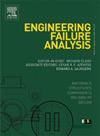某炼油厂常压蒸馏装置辐射管失效原因分析及损伤机理
IF 4.4
2区 工程技术
Q1 ENGINEERING, MECHANICAL
引用次数: 0
摘要
本文研究了炼油厂常压炉辐射管失效的根本原因。油管失效导致原油泄漏,造成重大损失。这项研究包括收集数据、回顾记录、测量各点的剩余壁厚,并对受损的试管进行详细的视觉和显微镜检查。用显微镜分析了裂纹路径及其边缘。为了进行比较,对失效管和未使用的相同材料的管进行了化学成分分析。利用扫描电子显微镜(SEM)和能谱仪(EDS)进行金相组织分析。采用扫描电镜(SEM)和能谱仪(EDS)对表面腐蚀进行了目测和分析,并用x射线衍射仪(XRD)对腐蚀产物进行了鉴定。在不同的点进行硬度测量,并进行拉伸试验,以比较失效和未使用的管的机械性能。结果表明,由于火焰或燃烧产物撞击管表面,局部温度升高。此外,由于焦炭沉积在管内,传热减少。外部腐蚀机制,如结垢和燃料灰腐蚀,显著降低了管的厚度。观察结果包括渗碳、碳化物连续网络的形成、碳化物生长、碳化物球化和钢的软化。最终破坏发生在厚度减小导致应力增大的情况下,局部温度升高进一步加剧了这一破坏。这最终导致蠕变引起的晶界开裂,并伴有轻微的塑性变形。本文章由计算机程序翻译,如有差异,请以英文原文为准。
Root cause analysis and damage mechanisms of radiant tube failure in the atmospheric distillation unit of an oil refinery
This study investigates the root causes of the failure of a radiant tube in the atmospheric furnace of a distillation unit of a refinery. The tube’s failure resulted in crude oil leakage and significant damage. The research involved collecting data, reviewing records, measuring the remaining wall thickness at various points, and conducting detailed visual and microscopic examinations of the damaged tube. The crack path and its edges were analyzed using microscopy. For comparison, chemical composition analyses were performed on both the failed tube and an unused tube of the same material. Metallographic microstructure examinations were conducted using a Scanning Electron Microscope (SEM) equipped with Energy Dispersive Spectroscopy (EDS). Surface corrosion was visually inspected and analyzed with SEM and EDS, while corrosion products were identified using X-ray diffraction (XRD). Hardness measurements were taken at different points, and tensile tests were conducted to compare the mechanical properties of the failed and unused tubes. The results indicated that localized temperature increases occurred due to the impingement of flames or combustion products on the tube’s surface. Additionally, heat transfer was reduced because of coke deposition inside the tube. External corrosion mechanisms, such as scaling and fuel ash corrosion, significantly decreased the tube’s thickness. Observations included carburization, the formation of continuous networks of carbide, carbide growth, carbide spheroidization, and softening of the steel. The final failure happened under increased stress resulting from the reduced thickness, which was further aggravated by localized temperature rises. This ultimately led to creep-induced cracking at the grain boundaries, accompanied by minor plastic deformation.
求助全文
通过发布文献求助,成功后即可免费获取论文全文。
去求助
来源期刊

Engineering Failure Analysis
工程技术-材料科学:表征与测试
CiteScore
7.70
自引率
20.00%
发文量
956
审稿时长
47 days
期刊介绍:
Engineering Failure Analysis publishes research papers describing the analysis of engineering failures and related studies.
Papers relating to the structure, properties and behaviour of engineering materials are encouraged, particularly those which also involve the detailed application of materials parameters to problems in engineering structures, components and design. In addition to the area of materials engineering, the interacting fields of mechanical, manufacturing, aeronautical, civil, chemical, corrosion and design engineering are considered relevant. Activity should be directed at analysing engineering failures and carrying out research to help reduce the incidences of failures and to extend the operating horizons of engineering materials.
Emphasis is placed on the mechanical properties of materials and their behaviour when influenced by structure, process and environment. Metallic, polymeric, ceramic and natural materials are all included and the application of these materials to real engineering situations should be emphasised. The use of a case-study based approach is also encouraged.
Engineering Failure Analysis provides essential reference material and critical feedback into the design process thereby contributing to the prevention of engineering failures in the future. All submissions will be subject to peer review from leading experts in the field.
 求助内容:
求助内容: 应助结果提醒方式:
应助结果提醒方式:


